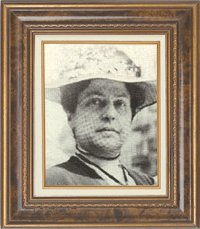|
Home > Healthy Living >
Women Inspiring Hope and Possibility > Lillian Wald
Lillian Wald
(1867-1940)
LINKS ON
THIS PAGE
Overview
Education and Training
Career Path
Selected Achievements
Public Health Practice Today
CDC's Role
Related Links
Overview
Lillian Wald
was born in Cincinnati, Ohio in 1867. She made significant contributions
through her establishment of public health nursing. She died in 1940.
Education and Training
- Nursing
degree from the New York Hospital Training School for Nurses
-
Postgraduate studies at the Woman's Medical College
Career Path
- Founder
and head of the Henry Street Settlement, a neighborhood center that
included nurses' training, nursing services, community education programs,
and youth clubs
- Organizer
of many district nursing service centers throughout New York
Selected Achievements
- Organized
a class in home nursing for the poor immigrant families on the Lower East
Side of New York
- Extended
her nursing services staff from the Henry Street Settlement to a local
public school, influencing the municipal board of heath to institute a
city-wide public school nursing program, the first such program in the
world
- Influenced
health insurance companies to provide free visiting public health nurses
to their policy holders
- Founded
and became the first president of the National Organization for Public
Health Nursing, designed to set professional standards for public health
nursing
- Championed
the causes of public health nursing, housing reform, suffrage, world
peace, and the rights of women, children, immigrants, and working people
Public Health Practice
Today
According to
the Institute of Medicine, a public health professional is defined as a
person educated in public health or a related discipline employed to improve
health through a population focus. Public health nurses, environmental
health scientists/specialists, health educators, epidemiologists, and health
information specialists are expected to be top priority needs in public
health in the next few years. Nurses are important to health because they
play key roles in protecting the health of all people; are in direct contact
with patients, families, and communities from many cultural and
socioeconomic backgrounds; and have the credibility and access that enables
them to provide scientifically sound information about health issues.
CDC's Role
CDC continues
to build on the work done by Lilian Wald.
CDC and the Agency for Toxic Substances and Disease Registry (ATSDR) work
with nurses to help ensure the safety and health of the nation. Examples
include:
- The
American Association of Occupational Health Nurses develops and
disseminates environmental health information as part of a cooperative
agreement with ATSDR.
- The
American College of Nurse Midwives has partnered with CDC to educate nurse
midwives and the public about diethylstilbestrol, safe motherhood, and
other issues impacting women.
- The
Working Group on Nurse Staffing and Healthcare-Associated Infections,
composed of 12 nurses and others, was convened by CDC to exchange
information and research on the association between healthcare-associated
infections and nurse staffing and to provide input to the CDC and nursing
leadership about steps needed to address this issue.
- The
National Institutes of Health and ATSDR collaboratively organized and
hosted a roundtable on nursing and environmental health, convened in
August 2002. The roundtable brought together representatives from schools
of nursing and public health, state and local health departments, national
organizations, and federal agencies. The goal of the roundtable was to
identify areas for potential collaborative initiatives to advance
environmental health nursing in the areas of research, education, and
translation to practice.
- The CDC
works with nurses in state and local health departments to implement
disease prevention and health promotion programs on a variety of issues on
an ongoing basis.
CDC strives
to strengthen the public health system through workforce development,
information system development, laboratory improvement, and system research
and development. Activities include:
- Delivering
distance learning opportunities through the Public Health Training Network
- Providing
opportunities to health professionals in 27 states through the Public
Health Leadership Institute
- Providing
state-of-the-art public health laboratory methods through the National
Laboratory Training Network
- Developing
regional or country public health management training programs in Nigeria
and Vietnam through the Sustainable Management Development Program
- Linking
the public health community to the Internet, providing access to online
information, and strengthening information system integration through the
Information Network for Public Health Officials
Related Links
American
Association of Occupational Health Nurses
http://www.atsdr.cdc.gov/HEC/natorg/aaohn.html
American Nurses Association
http://www.nursingworld.org/(Non-CDC site)
ATSDR
Environmental Health Nursing Initiative*
http://www.atsdr.cdc.gov/EHN/2nursinghomepage.html
CDC/ATSDR Public
Health Workforce Development Initiative
http://www.phppo.cdc.gov/owpp/workforcedev.asp
CDC Promotes Health through Strong
Partnerships
http://www.cdc.gov/about/partners.htm
CDC's Funding Opportunities
http://www.cdc.gov/about/funding.htm
CDC's Prevention Research Centers
http://www.cdc.gov/prc/
CDC's Public Health Practice Program
Office
http://www.phppo.cdc.gov/
Diethylstilbestrol (DES) Educational Tools for Nurses
http://www.cdc.gov/des/hcp/resources/tools_nurses.html
Impact of Nurse
Staffing on Patient Safety
http://www.cdc.gov/ncidod/hip/nursing/staffing.htm
Lillian Wald*
http://www.us-israel.org/jsource/biography/wald.html
National League for Nursing
http://www.nln.org/index.cfm (Non-CDC site)
Nurse Staffing and Healthcare-Associated Infections*
http://www.cdc.gov/ncidod/hip/nursing/staffing_ref.htm
Nursing and Environmental Health*
http://ehp.niehs.nih.gov/docs/2003/111-2/extram-speaking.html
(Non-CDC site)
Nursing
History: Lillian D. Wald*
http://www.nurses.info/personalities_lillian_wald.htm
(Non-CDC site)
Wald,
Lillian D.*
http://search.eb.com/women/articles/Wald_Lillian_D.html
*Used as a
source for this Web page.

 This site contains documents in PDF format. You will need Adobe Acrobat Reader
to access the file. If you do not have the Acrobat Reader, you may download a
free copy from the
Adobe Web site.
This site contains documents in PDF format. You will need Adobe Acrobat Reader
to access the file. If you do not have the Acrobat Reader, you may download a
free copy from the
Adobe Web site.
Home | Site Map |
Contact Us
Privacy Policy |
Disclaimer | Accessibility
CDC Home |
Search |
Health Topics A-Z
This page
last reviewed March 26, 2004
URL: http://www.cdc.gov/women/owh/history/wald.htm
US
Department of Health and Human Services
Centers for Disease Control and Prevention
Office of Women's Health
|


